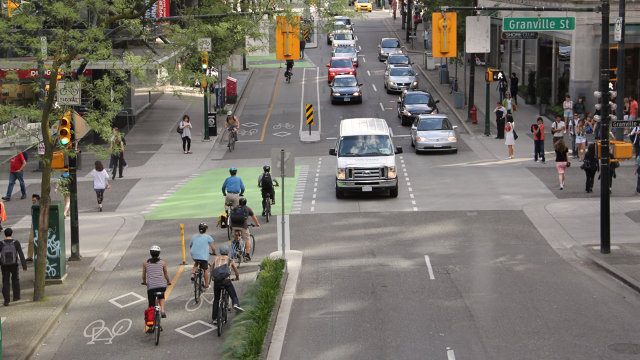
Price Tag editor Ken Ohrn is one of the founders of HUB, the coalition of concerned cyclists across Metro Vancouver. We were talking about the remarkable story of cycling in Metro Vancouver, and the fact that within one decade HUB and its predecessor the Vancouver Area Cycling Coalition (VACC) have solidly put cycling on the urban agenda, and worked tirelessly for seamless, safe and separated cycling connections across the region.
The case has been made for the economic benefits of cycling and cycling lanes. Studies undertaken in Toronto and New York City commercial areas clearly show that people traveling by walking, cycling, and transit spend more per month and visit more often than those people traveling by cars. My TEDX talk references studies in Toronto and New York City which clearly show that supporting active transportation augments shops and services’ bottom line.
For those people who are in cars, bike lanes are good too-the protected lanes in New York City actually allow car traffic to go faster through the city. This report from the New York City’s Department of Transportation written in 2014 shows that bike lanes allow vehicular traffic to flow faster, and that pedestrian injuries decrease by 22 per cent on streets with bike lanes. Cycling injuries have gone down by as much as 65 per cent on previously troublesome streets.
Why do cars flow faster? “Cars turning left now have pockets to wait in-so they’re less likely to hit a cyclist riding straight, but they also stop blocking traffic as they wait”. The result is better visibility for the motorist and the cyclist, and helps the traffic flow.
It’s worth taking a look at the NYC Department of Transportation link to see how the data is collected and interpreted. As past commissioner Janette Sadik-Khan said in her talk in Vancouver earlier this year “In God we trust, but everyone else bring data“.
New York City’s data shows us the way forward. One separated bike lane at a time.













Well, to be fair, the improved demarcation of vehicle lanes – and the speed/operational benefits for cars this provides – is an additional benefit to a whole traffic calming package. This is not a necessary outcome of the cycle lanes themselves. One can install cycle lanes and not get these same speed/operational benefits. Similarly, one can get these benefits (for cars) without the cycle lanes.
In Manhattan, poor network performance for vehicles was largely the result of continuous taxi weaving and delays behind left-turning vehicles. In Times Square, for example, the removal of the wonky diagonal approaches at intersections, in addition to many taxis now avoiding the area, allowed north/south and east/west traffic more ‘green time’ per phase and ultimately to move more quickly through the area.
Cycling infrastructure is a great way to use the additional width created by reducing and rationalizing car space, which in turn can have network benefits for drivers. But I’d advise against upselling cycling infrastructure in and of itself as a means of improving vehicle or corridor speeds.
If only you could say the same about Dunsmuir. The traffic engineers mailed it in on that one.
Each intersection from Beatty to Homer has different turn lanes configurations. Beatty has a right turn lane, but no left. Cambie has right and left turn lanes. Hamilton has a right turn lane, but no left (but has space for one?). At least the section from Homer to Burrard is a bit more consistently planned.
If anything, city planners had to work a lot harder on Dunsmuir. Every intersection has its own requirements and characteristics and the approaches’ designs respond to each in kind. Depending on the volumes, some need the dedicated left, others need a dedicated right. Consistency of the approach design isn’t that important. Making sure the thing still ‘works’ as well as possible for all modes is.
In NYC, the north/south avenues had 6-7 lanes of road space to play with. On Dunsmuir, there were 4, so harder decisions had to be made with regards to what vehicle bays could be kept after space was allocated to the cycle lanes. I think they did an incredible job downtown, especially with so much ‘end is nigh’ doom-wailing from businesses and driving commuters. I’m looking forward to the next round of lanes.
I think they blew it on Beatty mainly. They should have put a left turn lane in somehow. Perhaps taking a chunk out of the sidewalk on the right side and realigning the lanes.
That intersection and the light timings is the main reason there are backups on the viaducts every evening.
Those wide sidewalks are very full when events are starting/ending at Rogers Arena.
Won’t this issue go away when the Dunsmuir viaduct comes down?
Author
Reblogged this on Sandy James Planner.
Back when anti-cycling infrastructure rhetoric first started, I wondered why motorists would be against something that benefitted them.
Previously they had complained that slow-pokes (cyclist) were in their way and that they shouldn’t be there, they insteadyshould have their own place to be (and not in front of them). That’s an understandable opinion but then they turned around and decided to be against the slow-pokes having their own place to be.